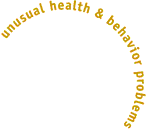|
|
||||||||||
   |
supplemental
feeding
Here is a site that sells nipples that were originaly designed for feeding kittens (the product is called Catac Nipples): Wildlife Rehabiliation Store Note:
Some vets recommend tube feeding for kittens. If yours does, have
the vet demonstrate tube feeding for you and follow their instructions.
Here's a link to help you: tube
feeding instructions Kitten formula. I found that the pre-made liquid was the most convenient, and that Just Born stayed fresh the longest, but any formula, powdered or liquid, made especially for kittens (not a general small animal formula) will be fine. The KMR liquid only kept for three days after opening, so I ended up throwing it out before I could use it all. The Just Born liquid keeps in the fridge for 14 days after opening. The powdered formula can be frozen while still in powder form. Buy three 8-ounce containers of liquid or the canister of dry formula, so that you are stocked up for a couple of weeks. Running out of formula is no fun. The cost of kitten formula and other items can really add up. Try my kitten coupon page to save some money on kitten stuff. Old towels that can be rolled up to act as "feeding inclines." The kittens need to be fed on their stomachs, with their front halfs raised up a little, so they can swallow their formula. Books usually suggest putting a towel on your leg and feeding the kitten inclined on the towel, but I found this to be very uncomfortable, and it was hard for me to see what I was doing. Whatever position that makes you comfortable is fine, as long as the babies are on their stomachs with their front half a little higher than their back half. Small cup and bowl for warming up formula. A plastic milk jug wrapped in a towel. The kittens can snuggle it when Mom’s away. A thermometer to monitor the temperature of the nursery. It should be 85 to 90 degrees the first week, 80 to 85 degrees the second, 75 degrees the third, and around 70 degrees thereafter. Yes, many kittens have survived in colder conditions...but it’s harder for them because they must use energy to keep warm and they don’t digest their food as well. A product called Pet Tinic. We got ours from the vet. It is a liquid vitamin supplement that might increase your kittens’ chance of survival. Non-clumping cat litter and a shallow litter pan or cake pan. This is important because kittens tend to ingest a lot of litter and clumping litter can make them sick or possibly kill them by blocking their intestines. Although the evidence is scanty on the dangers, there is indeed a warning on many brands of clumping litter stating that kittens should be supervised to ensure that they do not consume the litter. Since most of us aren't around our kittens 24 hours per day to supervise them, it's probably best to forgo clumping litter entirely. “Scoopable” is fine, as long as it isn’t “clumping.” A kind of litter that most cats will use without a fuss is SWheat Scoop. Avoid using clumping litter until the kittens are about four months of age. Also, some cat owners have suggested staying away from PearlFresh. The pearls seem to get stuck in kitten mouths, etc., so it is not as safe as it appears to be. The book "The Cat Owner's Guide to Home Veterinary Care." It has, by far, the most complete kitten care section I have encountered. Below
is a link to the book at amazon.com, if you'd like more details.
|
|||||||||